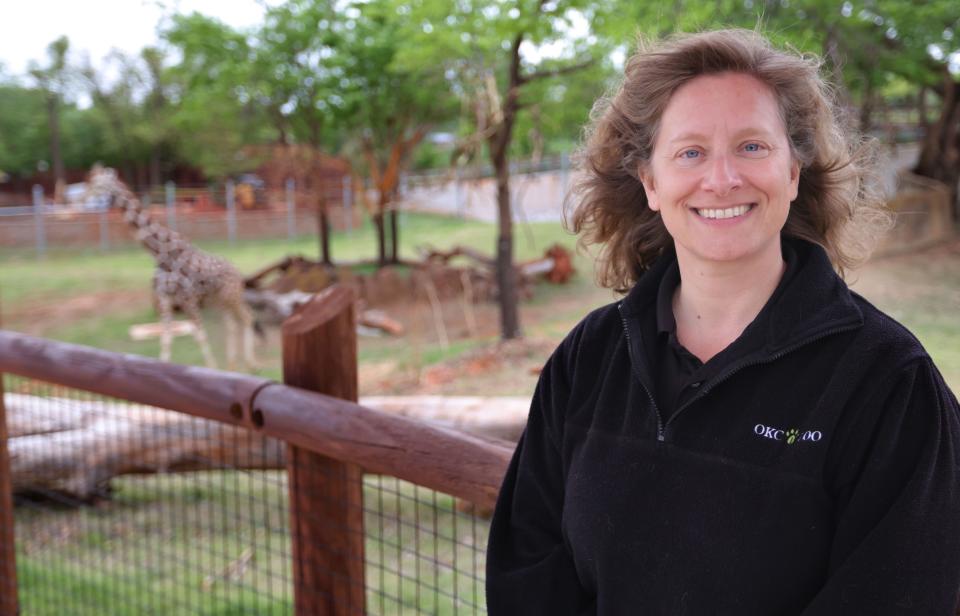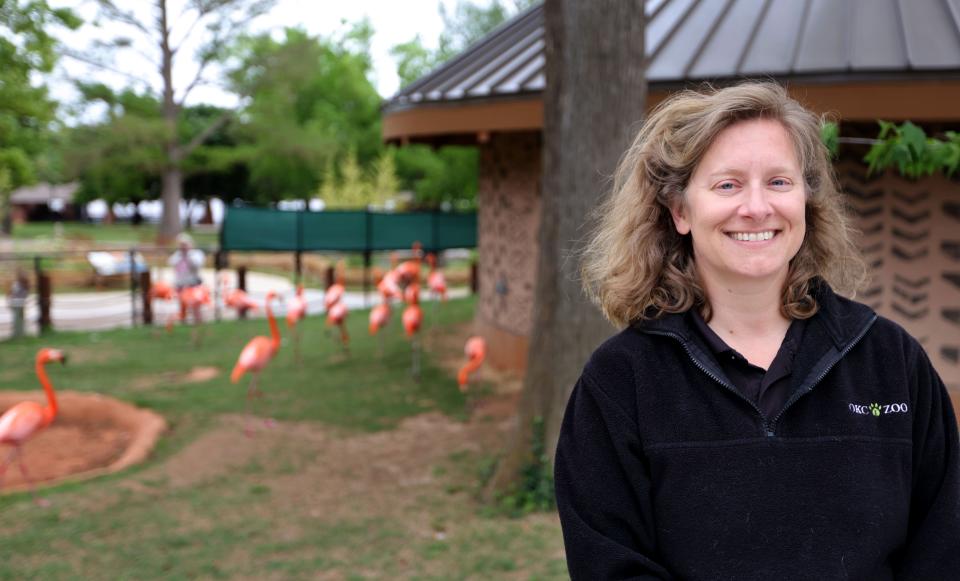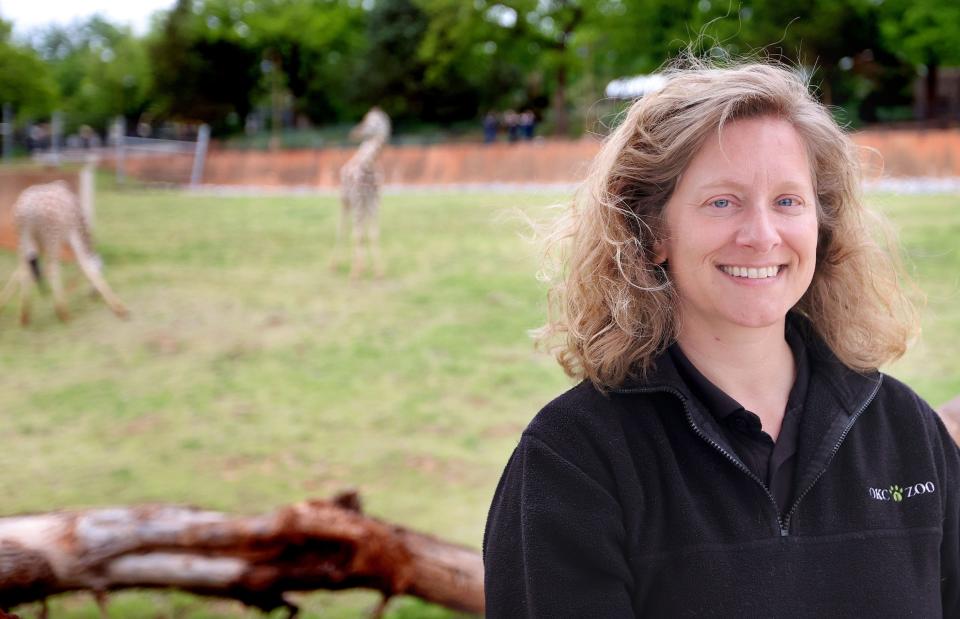Who chooses the animals that live at OKC Zoo? Meet the zoo's chief of animal programs
In the middle of Oklahoma City, wild cats lounge, giraffes stretch for trees and gorillas munch alongside more than 1,000 animals under the care and direction of Dr. Jennifer D’Agostino, chief of animal programs officer. She oversees current and future animal programs and the veterinary department.
Growing up in Michigan around her grandma’s working farm fostered D'Agostino's love of animals.
“I remember following the vet around when he’s doing his checks of the horses and stuff like that. I just knew that was what I was going to do with my life,” she said.
D’Agostino moved to Oklahoma City 21 years ago and completed her residency specializing in zoo animals. She was promoted to head veterinarian, then to director of veterinary services in 2008 and then to her current position this past February.

Choosing which animals live in the zoo is one of her responsibilities, like the new Expedition Africa exhibits. She considers what people want to see, what her staff can take care of and what fits well in Oklahoma’s climate. She gets advice and support through a national Species Survival Program established by the Association of Zoos and Aquariums. The program provides breeding information to zoos and facilitates the movement of animals from one zoo to another. Its goal is to encourage zoo patrons to learn about animals and support conservation efforts for their counterparts in the wild.
The zoo is held to a high standard of care, including everything from habitats to nutrition and veterinary care. Many of the animals have been trained to lean against a mesh barrier to receive an injection. Some can put their paw or tail through a safety port for a blood draw. Gorilla males receive heart ultrasounds when they step up to the mesh barrier and vets can get a full heart exam. It’s less stressful, D’Agostino explained.
More: OKC Zoo's Expedition Africa habitat now open: See Pachyderm building updates, zoo babies
A bachelor’s degree isn’t required for every zoo career, but an animal science or zoology degree is a great start, she said. College students can apply for a paid summer internships.
The zoo was established in 1904 at Wheeler Park with a single white-tailed deer. It was moved to Lincoln Park after a 1923 flood and now is considered to have one of the nation's finest collections of antelopes and other horned ungulates.

Q: What’s your favorite part of the job?
A: I think that my favorite part of the job is the diversity. It’s different every single day. You never know what’s going to be thrown at you and you have to think on your feet … just knowing that I’m helping these animals live their best lives and be ambassadors for their wild counterparts because I’m passionate about conservation and I want them to continue to live in the wild. I want people to get excited about these animals and care about them so that they will do their part to help with conservation efforts, as well.
Q: What’s the most misunderstood part of working at the zoo?
A: I think the most misunderstood thing is that people think we come to work all day and just play with the animals. That is 100% not true. We do have close working relationships with them because they do have to trust us, and we do a lot of behavioral training and things. Most of the day is preparing their food, cleaning up after them and maintaining their habitats and not necessarily interacting with that individual animal. You’re doing other hard physical labor all day. The only time we touch a lion is when it’s a little bitty cub and it gets its vaccines and then we give it back to mom. And then when they’re like 16 weeks old, we can’t touch them anymore because they’re nasty and they’re too big.
Q: Do you notice any dynamics or drama among the animals?
A: All of the animals have individual personalities, and they have their social dynamics, and sometimes the social dynamics are quite harmonious all the time and sometimes they fluctuate. Like African painted dogs. They’re always trying to figure out their hierarchy and they have a very distinct social structure and very distinct rituals with each other for greeting each other every day. It’s really fascinating to watch.
Q: What’s the most memorable animal behavior you’ve seen?
A: Probably when Malee (an Asian elephant) was born. She was our first elephant ever born at the zoo. Mom was Asha and it was her first baby, and it was our first baby. We were all learning together. When they have their first one, you think instinct kicks in, but they’re still like “This is really painful. Like what the heck is happening? I don’t know what’s going on.” She was fighting it. Finally, we had to assist her a little bit to get her to kind of push and contract. It was funny because then when she had the baby, you could almost see it in her face, she was like “Oh that feels much better.” Then she saw the baby and she trumpeted, but she was just kind of like, “What the heck is that?” Then she smelled it, and you could see her relax. She’s like, “Oh that’s mine. That smells like me.” The next one, it was just like, “Boom, I know what I’m doing.”
Q: What is your favorite animal to take care of?
A: That’s so hard. It’s changed over the years because my answer always used to be the cats. That’s what I love because I’m a cat person. I think my favorite are the elephants. I’ve done a lot of work with the elephants, so I’m very heavily involved in that world.
Q: What happens when there's severe weather?
A: When it's the most severe, all animals are brought indoors and secured indoors so that if something were to happen, they're in a more secure place. If it's a lesser degree, certain animals that are more sensitive might be secured indoors. Others might have access to their indoor space so they can go into shelter if they so choose, but could stay outside, as well. If there's a tornado coming, they're all inside.

Q: How do you respond to people who say it's cruel to put animals in zoos and they should stay in their wild habitat?
A: We fully agree that these animals should be in the wild. Not everybody gets to go to Africa or Asia ... but when you come here, you can get that sort of up-close experience, see how they behave, see how they interact with their herd mates and siblings and parents and all that stuff and really fall in love with them. Our goal is to provide them all of the same opportunities that they would get in the wild. We also do a lot of regular well-being assessments at least once a year for every animal, but oftentimes it's more frequent than that because there's a change in social structure or we have construction or something's going on, and when those types of things happen, we do increased monitoring.
This article originally appeared on Oklahoman: OKC Zoo's chief of animal programs officer talks animal care

